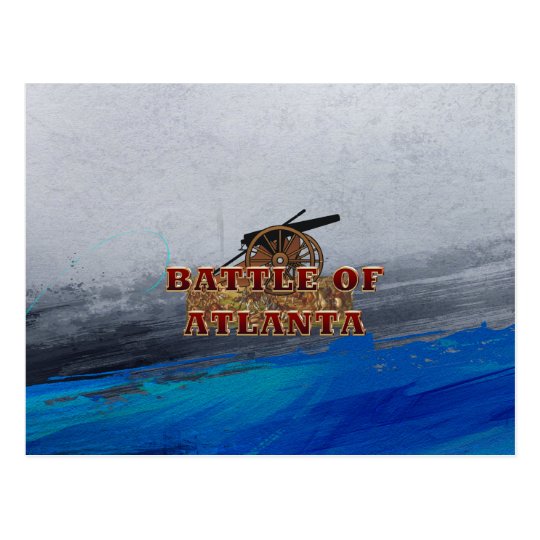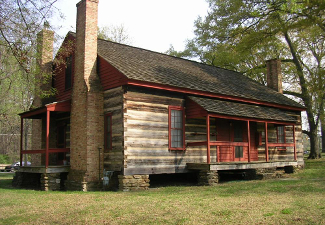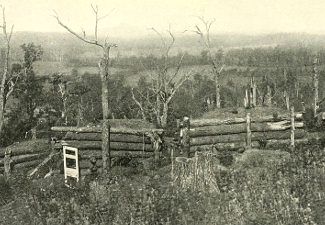
Photo above: Union soldiers on horseback during the Siege of Atlanta, 1888, Thure de Thulstrup, L. Prang and Company. Right: The Battle of Resaca, Kurz and Allison, 1889. Courtesy Library of Congress.
Atlanta Campaign, Civil War 1864
General William T. Sherman would march into northern Georgia toward Atlanta, his eventual goal to occupy the manufacturing city and then March toward the Sea. He had one hundred and ten thousand troops in part two of the Grant strategy to end the war. So while Ulysses S. Grant and General Meade sieged Richmond and Petersburg after battles at the Wilderness and Spotsylvania to his north, Sherman would begin his march. Today, the sites of what would be known as the Atlanta Campaign are less interpreted, outside of Kennesaw Mountain, than Civil War historians would like, but that does not make them any less important. Because when General Sherman and Union troops started May of 1864 at battles north of Atlanta at Rocky Face and Resaca, it would start over four months of devastating attacks against the Confederate south that would prompt a famous movie, Gone with the Wind, and point, just as importantly, toward Appomattox and surrender as anything Grant and Meade would do in Virginia.
Click here to Sponsor the page and how to reserve your ad.

Atlanta Campaign Then
General William T. Sherman invaded Georgia from the Chattanooga area in early May 1864, focusing his forces against those of Confederate General Joseph E. Johnston. Johnston had 53,800 troops within his command, with reinforcements to arrive adding 15,000 more. The battles began with a series of small skirmishes, the first at Stone Church. They escalated as Johnston and his Army of the Tennessee retreated back toward Atlanta, including major battles at Resaca, Kennesaw Mountain, Peach Tree Creek, and a series of battles around the city of Dallas, Georgia.
By mid-July, the Confederate heirarchy had become disenchanted with Johnston's command, even though he had some success at stalling Sherman's movement south at the Battles of New Hope Church and Kennesaw Mountain. But Sherman's superior amount of troops could not be stalled much longer, and after crossing the Chattahoochie River on July 8, Confederate President Jefferson Davis replaced Johnston on July 18 with a more aggressive General John B. Hood. It did not matter much; Union troops were within five miles of the city. Hood's frontal assaults could not prevent Sherman's Union Army from attacking the environs of Atlanta, culminating in the Battle of Atlanta and Battle of Jonesboro where Union troops outmaneuvered and outnumbered Confederate forces 70,000 to 24,000. The Atlanta Campaign was over on September 2. Sherman took over the city, then marched toward the sea. Casualties for the campaign reached nearly 70,000 men, almost equally divided between Union and Confederate forces.
Timeline of the Atlanta Campaign
May 1 - Skirmish at Stone Church.
May 2-7 - Skirmishes at Lee's Cross Roads and Ringold Gap (2), Varnell's Station Road (4), Tunnel Hill (5-7), Varnell's Station and Nickajack Gap (7).
May 7 - Battle of Rocky Face Ridge (Mill Creek Gap and Dug Gap)
May 13 - Skirmish/Demonstration at Dalton and Tilton.
May 13-15 - Battle of Resaca
May 15-24 - Skirmishes and small battles at Armuchee Creek (15), Rome (15-17), Floyd's Spring and Calhoun (16), Adairsville/Cassville (17, 18-19, 24), Pine Log Creek (18), Kingston (18-19), Etowah River (20), Stilesborough (23), Dallas (24).
May 25-26 - Battle of New Hope Church
May 27 - Battle of Pickett's Mill
May 28 - Battle of Dallas
May 27-29 - Skirmishes and battles in Alabama at Pond Springs (27) and Moulton (29)
June 9-30 - Skirmish Battles at Big Shanty (9), Stilesborough (9), Calhoun (10), Marietta (10 - July 3), Lafayette (24).
June 22 - Battle of Kolb's Farm
June 27 - Kennesaw Mountain
July 4-19 - Skirmish Battles at Ruff's Mill, Rottonwood Creek and Neal Dow Station (4), Chattahoochie River Line (5-17), Rosseau's Raid (10-22), Buckhead (18).
July 20 - Battle of Peach Tree Creek
July 20-24 - Skirmish Battles in Leggett's Hill (20), Covington Raid (22-24), Cartersville (24).
July 22 - Battle of Atlanta
July 22 to September 2 - Siege and Battles Around Atlanta
July 27-31 - McCook's Raid
July 27 - August 6 - Stoneman's Raid
July 28 - Battle of Ezra Church
August 4-7 - Battle of Utoy Creek
August 10-31 - Skirmish Battles at Dalton (14-15), Sandtown and Fairburn (15), Lovejoy Station (20, September 2-5), Red Oak (29), East Point and Flint River Bridge (30), Rough and Ready Station (31).
August 31 - September 1 - Battle of Jonesboro
September 2 - Union Troops occupy Atlanta.
Photo above: Ruins of the Atlanta Roundhouse after the Civil War, 1866, George N. Barnard. Courtesy Library of Congress via Wikipedia Commons. Below: Battle of Jonesboro, 1864, Currier and Ives. Courtesy Library of Congress.

Atlanta Campaign Now
There's much to see, but not nearly as comprehensive, outside of the Kennesaw Mountain Battlefield, than historian and history tourists would like. But there are plenty of battle markers down many roads, and battlefields of Resaca, Pickett's Mill, and Dallas to explore that are well worth a visit, even to modest Civil War fans. The Atlanta History Center, with the new Whitaker Cyclorama Center now open as of February 2019, contains perhaps the most compelling remnant about the Atlanta Campaign story, the Battle of Atlanta Cyclorama, now refurbished. Of course, some will consider Gone With the Wind a better representation. That's up to you to decide, of course.
T-Shirts and Souvenirs

Atlanta Campaign and the Battle for Atlanta Civil War T-Shirts and Souvenirs. Official gear from America's Best History.

Atlanta Campaign
Things You Should Not Miss
1. It's the most complete experience about a battle of the Atlanta Campaign, so you must visit Kennesaw Mountain Battlefield Park. View the thirty-five minute film, take a ranger walk, and wander through the exhibits. A shuttle will take you up to the summit during the weekends; your own car will do the trek at other times.
2. Since 2016, you can visit the one thousand acres preserved at Resaca Battlefield Historic Park and other area Battleof Resaca sites. There's no Visitor Center at the main battlefield, but lots of waysides to read and hikes to be engaged in.
3. With the Battle of Atlanta Cyclorama now restored and open, the new Whitaker Cyclorama Center at the Atlanta History Center provides a spectacular sound and light experience of one major battle of the Atlanta Campaign, the Battle of Atlanta itself. Along with exhibits, the Texas train, and other interpretation, it will be a must see if you're into Civil War and Atlanta history. And if the restoration is anything like that done with the Gettysburg Cyclorama, and we're sure it will be, you won't want to miss it.
4. If you have the time, check out Pickett's Mill Battlefield in Dallas. There's over seven hundred acres there to wander around and ponder the Civil War as it pushed toward its conclusion, Georgia style.
Photo above: Kennesaw Mountain Battlefield. Courtesy Library of Congress.





